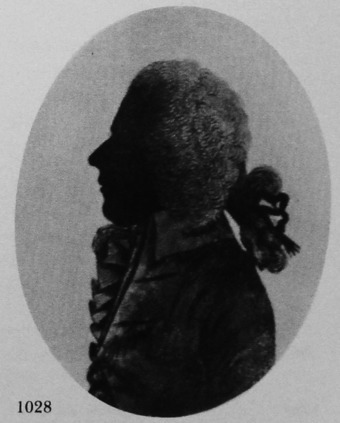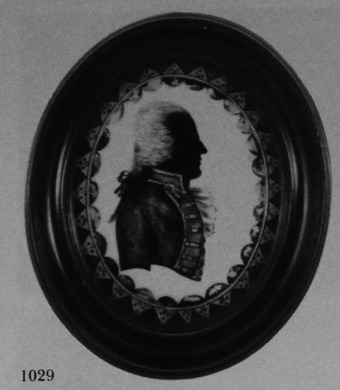Bull, Mrs (McKechnie Section 3)
See Section Two for main entry
I have suggested in Section Two that Mrs Bull first worked for Mrs Beetham c. 1785-86, and later worked independently in Leadenhall Street. I have seen no example on glass backed with Mrs Beetham's trade labels, but I have seen two or three examples dating from c. 1788-90 which suggest that in Leadenhall Street Mrs Bull did paint a few examples on this surface: a type of work of which she had seen a good deal at 27 Fleet Street. One of these examples shows rather inexpert handling of verre églomisé — a technique, brilliantly employed at 27 Fleet Street by Edward Beetham, which Mrs Bull appears to have attempted to reproduce.
The earlier of the two illustrated examples (a silhouette of a Mr Ramsay) seems to have been painted c. 1788-90 and shows many of the characteristics of Mrs Bull's painting on paper. The brushwork on the hair is very similar, as is the zigzag hatching showing the edge of the waistcoat beneath the conspicuously large button with which the sitter's frock (typical of the period) is closed. Though the painting of the shirt-frill is different, the rendering of the pigtail ribbons closely resembles Mrs Bull's work on paper. There is no bust-line termination on this silhouette; nor is there on two paper examples which I have ascribed to Mrs Bull, though they are backed with Mrs Beetham's trade labels. On this silhouette costume detail is indicated by coarse lines of hatching against a more finely hatched background. As I have seen only a photographic reproduction of this silhouette, I cannot say whether or not a fingerprinted base was used for the finely hatched background, but if this example is indeed by Mrs Bull it is likely that she would have used such a base, since she would have followed Mrs Beetham's technique.
The same amount of hatching can be seen on the second illustrated example (sold by Sotheby Parke Bernet, London, on 10 March, 1975) ascribed to Mrs Bull. The sitter is a naval officer, probably a captain. Both the painting of the shirt-frill and the bust-line termination closely resemble those on the artist's paper silhouettes. The facings on the jacket are painted against a fingerprinted base, and the anchors on the buttons are clearly shown. The presence of these buttons indicates a date of after 1787; the absence of an epaulette, a date before 1795. The pig-tail wig is of a type much worn c. 1790. The approximate date of this example, therefore, does coincide with the dates which I have given for the likely period when Mrs Bull was working in Leadenhall Street. The difference between the wig shown on this silhouette and the wigs shown on other silhouettes ascribed to the artist may be accounted for by the marked ‘brush' shape of the toupée (made on this wig of long, sweeping pieces of hair), not by any difference in the style of painting. The flat glass on which this silhouette is painted has an unusual verre églomisé surround. The outer edge is painted, in gold, in an arrow-shaped formation, each arrow containing a pattern of black dots. Inside the gold line which encloses the arrow-shaped devices is a swag design in green, not very skilfully painted. The differing size of the arrows near the foot on the right suggests that this verre églomisé was not the work of an experienced hand; it is possible that Mrs Bull painted it herself as an attempted variation on the style of verre églomisé, painted by the trained hand of Edward Beetham, which she had seen in the Fleet Street studio.
In Two Centuries of Silhouette Mrs Peggy Hickman illustrates a silhouette print of Philip Astley (1742-1814), engraved by J. Smith after an original which Mrs Hickman ascribes to Mrs Bull. If the original of this print is indeed by Mrs Bull, it seems likely that it was painted on glass, for it has more characteristics in common with the two glass profiles which I have just described than with any silhouettes painted by Mrs Bull on paper.
Ills. 1028, 1029

Mr Ramsay
Silhouette pained on glass
c. 1788-90
From E. Nevill Jackson, ‘The History of Silhouettes’ (1911), by courtesy of the ‘Connoisseur’

Unknown naval officer
Silhouette painted on flat glass, with gold and green verre églomisé border
c. 1790
2½ x 1¾in./64 x 45mm.
Frame: pearwood
By courtesy of Sotheby Parke Bernet and Company, London
